Occlusal adjustment is a holistic dental approach aligning teeth and jaws for optimal mastication, alleviating issues like tooth wear, headaches, TMJ disorder, and bite problems. This integration of cosmetic and restorative dentistry enhances oral health, reduces physical discomfort, improves jaw mobility, minimizes gum disease risk, and increases overall well-being, requiring comprehensive assessment, tailored treatment plans, regular teeth cleaning, and long-term maintenance.
Occlusal adjustment, a precise balancing act involving your bite and jaw alignment, is often overlooked yet profoundly influences overall health and quality of life. This article delves into the fundamental concepts of occlusal adjustment, exploring how it can alleviate discomfort, improve oral health, and enhance well-being. We’ll guide you through practical steps to achieve optimal balance, offering a transformative journey towards a more comfortable, functional, and fulfilling life.
- Understanding Occlusal Adjustment: The Basic Concepts
- How Occlusal Therapy Improves Quality of Life
- Practical Steps to Achieve Optimal Occlusal Adjustment
Understanding Occlusal Adjustment: The Basic Concepts

Occlusal adjustment refers to the process of aligning and balancing the teeth to ensure they work together harmoniously during chewing, bite, and jaw movements. This involves adjusting the teeth, jaws, and muscles involved in mastication. By achieving proper occlusal harmony, individuals can experience significant improvements in their overall oral health and quality of life.
Comprehensive dental care recognizes the importance of occlusal adjustment as a foundational aspect of both cosmetic dentistry and restorative dentistry. Misalignments or imbalances can lead to a variety of issues, from tooth wear and chronic headaches to TMJ disorder and bite problems. Through careful examination and precise adjustments, dentists can not only address these symptoms but also prevent future oral health complications. This holistic approach ensures that the teeth are not only aesthetically pleasing through cosmetic dentistry techniques but also functional and comfortable for prolonged periods, enhancing overall well-being.
How Occlusal Therapy Improves Quality of Life

Occlusal therapy focuses on aligning and balancing the teeth and jaw to create a harmonious bite. This simple yet powerful adjustment can significantly enhance quality of life by alleviating physical discomfort associated with improper biting, such as headaches, facial pain, and muscle tension. By correcting misalignments, occlusal therapy reduces stress on the temporomandibular joint (TMJ), leading to improved jaw mobility and reduced risk of injuries from excessive wear and tear.
Furthermore, a properly aligned bite contributes to better oral hygiene, making it easier to maintain dental cleanings and prevent issues like gum disease. This is especially relevant in considering procedures like tooth extractions or wisdom tooth removal, as occlusal adjustment can ensure the remaining teeth are properly positioned, minimizing complications and promoting faster healing. Ultimately, these improvements translate into increased comfort, confidence, and overall well-being, demonstrating the profound impact of occlusal adjustment on daily life.
Practical Steps to Achieve Optimal Occlusal Adjustment

Achieving optimal occlusal adjustment requires a systematic approach that involves several key steps. First, a comprehensive assessment by a qualified dentist is essential to understand your dental anatomy and bite patterns. This may include X-rays, mouth impressions, and visual examinations to identify any misalignments or teeth grinding issues. Once the problem areas are identified, the next step is to develop a personalized treatment plan.
Restorative dentistry techniques play a vital role in occlusal adjustment, offering solutions like dental fillings, crowns, or even veneers to correct tooth positions. Emergency dental care services can also be beneficial for sudden, severe headaches or jaw pain related to teeth grinding. Regular teeth cleaning appointments are another crucial aspect, as they help maintain oral health and support the long-term stability of adjustments made. Through a combination of these practical steps, individuals can experience significant improvements in their quality of life, enjoying better sleep, reduced facial pain, and enhanced overall dental well-being.
Occlusal adjustment, a tailored approach to oral health, significantly enhances quality of life by alleviating pain and improving overall well-being. By understanding basic concepts, embracing occlusal therapy, and following practical steps, individuals can achieve optimal oral balance. This holistic approach not only revolutionize dental care but also underscores the deep connection between oral health and overall wellness.














